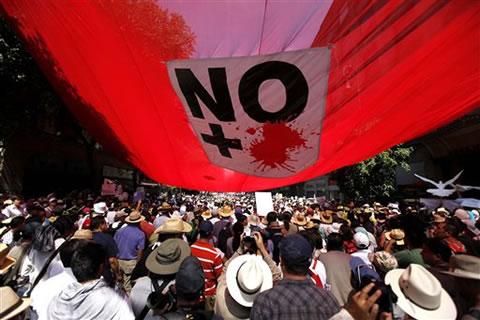Drugs smugglers are getting more and more creative in trying to circumvent drug trafficking and money laundering regulations either side of the Mexico-USA border. Flows of drugs northwards are counterbalanced by flows of cash southwards, since drug shipments have to be paid for somehow. What a shame that drug traffickers’ incredible ingenuity is not channeled into more legitimate and socially-responsible activities.
In March, one 33-year-old woman from Monterrey, Mexico, traveling back home from the USA, was apprehended aboard a trans-border bus with two teddy bears, each with their own pillow. How much cash can you stuff into two teddy bears? Well, if you add a couple of pillows into the mix, the answer is at least $277,556, since that is the total amount confiscated from Jeanette Barraza-Galindo. Her sentencing hearing is scheduled for September 8; she faces up to 5 years in prison and a $250,000 fine.
Just how can drug cartel leaders protect themselves and their assets, given the constant disputes between cartels and in-fighting within the cartels? Mexico’s luxury vehicle production has been doing suspiciously well for years; production of specialist armor-plated vehicles has been rising so rapidly that legitimate manufacturers are struggling to keep pace with demand. Drug capos consider armor-plated vehicles a necessity. So it perhaps not surprising that one cartel started its own production line. In June, the Mexican Army seized a factory in Camargo, Tamaulipas, that turned out armored vehicles for the Zetas, one of the most violent of Mexico’s drug gangs. In the process, it confiscated 28 vehicles, including four that were “ready to roll”, as well as numerous weapons.
What happens to the remains of drug lords killed in the war on drug cartels? Some of them end up occupying cemeteries that, for some future generation, will probably be viewed as macabre tourist attractions.
Perhaps the most extreme example is the Jardines de Humaya cemetery in Culiacán, Sinaloa, which has some of the most impressive funereal monuments in all of Mexico, up to and including mausoleums with stained glass, telephone lines and oriental rugs.
Where do all the guns come from? According to Jesús Enrique “El Mamito” Rejón, the answer is the USA. Rejón is a Zeta drugs gang boss, recently captured and interrogated by Mexican federal agents.
In the interview, Rejón says he deserted the Mexican Army in 1999 to join the Zetas. The Zetas have since become a multinational organization,purchasing drugs, according to Rejón, through accountants who buy them from Guatemala and then transporting them across Mexico and into the USA. He says all the Zetas’ weapons have been purchased in the USA, and then smuggled into Mexico by a variety of routes, including walking across the international bridges connecting the two countries. Rejón claims that the Gulf Cartel gets its weapons more easily than the Zetas, suggesting that their leaders must have made a deal, perhaps with border officials. One of the many individuals apprehended at the border in recent months by police and customs agents was, US authorities allege, supplying an order from the Gulf Cartel which included 200 AK-47 assault rifles.
Finally, there is some good news. As has been reported elsewhere —Mexico winning cartel war—Mexico does appear to be making progress against the cartels. Numerous cartel leaders have been arrested or killed. This has led to renewed clashes between cartels as some seek to exploit perceived weaknesses in their rivals. Some splinter groups appear to be leaderless; their rank and file have lost their previous sources of income and so are now engaging in more localized acts of petty crime. Unfortunately, these are investigated by poorly equipped state or municipal police forces, rather than their much better-equipped federal counterparts.
As elections loom, there are renewed calls for an end to the violence, which has cost more than 35,000 lives since 2007. Protest marches have been held in many major cities, including one that generated a massive turn out in Mexico City in May (see photo).
Last month, a “caravan of peace” comprised of more than 14 buses and 30 cars began a journey which will take it through some of Mexico’s most troubled regions, including Ciudad Juárez.
Here’s hoping that things soon begin to improve and that we will not need to compile many more updates to Mexico’s war against the drug cartels.
Previous posts about the geography of drug trafficking and drug cartels in Mexico:
- The geography of drug trafficking in Mexico
- The background to Mexico’s fight against drug cartels
- Mexico’s export trade in drugs
- The economic benefits to Mexico of the drugs trade
- Mexican drug traffickers expand their influence to Central America
- More impacts of Mexico’s war against drug cartels
- Drug gangs diversify their business activities
Geo-Mexico: the geography and dynamics of modern Mexico discusses drug trafficking, and efforts to control it, in several chapters. Buy your copy today to have a handy reference guide to all major aspects of Mexico’s geography!

Sorry, the comment form is closed at this time.